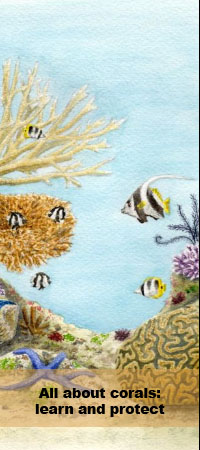|
Coral colonies and reefs form as calcareous (calcium carbonate) skeletons are deposited and bound by corals. Living hard coral polyps secrete calcium carbonate skeletons from their basal plates to form protective cups in which they then sit. These skeletons are added to as the coral polyps lift periodically from their cups to secrete new skeletons in which they will then rest. As coral polyps ‘bud’ (a form of asexual reproduction), new coral polyps develop forming additional basal plates from which further calcareous skeletons are secreted. Also as hard corals die, their skeletons remain within the framework to provide a platform for future coral growth. These platforms allow new corals to settle and grow over their predecessors. Overtime these processes lead to gradual growth of the coral reef framework.
Other reef builders…
Although these skeletons make up the majority of a coral reef framework, a number of other marine organisms contribute to reef growth as they add further calcium carbonate deposits and/or bind the hard coral skeletons.
Fire corals, which technically aren’t corals despite their name, can contribute large quantities of calcium carbonate to a reef framework as they secrete an internal calcareous skeleton.
Calcareous algae living on coral reefs deposit large amounts of calcium carbonate in their tissue. As they die and decompose, this calcium carbonate forms a skeleton that becomes incorporated into the reef structure. Some algae, such as coralline algae, grow outwards encrusting the reef framework trapping and cementing sediments in its fibres. This cementing process binds and strengthens the reef framework.
Marine sponges (phylum Porifera) of the class Calcarea are known as calcareous sponges as their structure is supported by tiny calcium carbonate bodies known as spicules. When living, marine sponges can help bind the reef structure but as they die and decompose, these spicules add further calcium carbonate to the structure thereby contributing to reef growth.
Although marine sponges can play a role in binding coral reefs, some marine sponges contribute to bioerosion (see threats). As ‘boring’ marine sponges tunnel into the reef framework small calcium carbonate sediments are formed which may become bound in the reef structure adding to its growth. Likewise, as the shells of molluscs breakdown they can form small fragments that may be incorporated into the reef structure.
Coral growth forms
Hard coral growth forms
As hard coral colonies expand and grow, their structures can develop into different morphologies or growth forms. These growth forms are generally referred to as branching, columnar, encrusting, massive, laminar, foliaceous and free living. Scientists today, use these growth forms to describe the appearance of different species of coral.
Branching corals, such as the thin birds-nest coral (Seriatopra hystrix), often found in areas of high wave action, are antler or staghorn-like in their appearance. Columnar corals, such as the catch bowl coral (Isopora palifera), are pillar or finger-like corals that form. Columnar corals do not have the secondary branches seen in the branching coral growth type. Encrusting corals, such as Leptoseris incrustans, are lichen-like in their form and are low spreading. Massive corals, such as the grooved brain coral (Diploria labyrinthiformis), grow slowly to form large, dome-shaped boulders. This shape gives them stability. Laminar corals, such as Acropora cytherea, have a flat upper surface which gives them a table-like structure. Due to their table-like shape, laminar coral are often referred to as table corals. Foliaceous corals, such as the pagoda coral Tubinaria mesenterina, are scroll-like in their appearance. Finally, solitary coral polyps that do not form colonies may be referred to as free-living. Solitary species include the mushroom coral Fungia scutaria species.
Coral growth rates
Coral growth rates are highly variable between species. In optimum conditions in the tropics, some coral species, such as the branching Acropora cervicornis, can display fast growth rates of between 10-20 cm per year while other species, such as Porites, grow much slower at around 1 cm per year.
In cold-water environments, the annual growth rates of corals are especially slow. For example, the annual growth rate for Oculina varicose is estimated at around 1.1-1.6 cm per year depending on coral depth while the growth rate of Lophelia pertusa corals on ship wrecks indicate growth rates ranging from 5-26 mm per year.
The growth rates of all coral species are heavily influenced by environmental conditions and can slow dramatically in response to disease and environmental disturbances including changes in ocean chemistry (salinity and acidification), rising ocean temperatures, sunlight and sedimentation.
Coral reef structures
Depending on their structural characteristics, coral reefs are generally described using three major reef types:
1) Fringing reefs, the most common type of the reef forms, extend seaward from the shore, sometimes separated by a narrow stretch of water or lagoon. They are generally found in shallow waters with the reef flats becoming exposed during low water.
2) Barrier reefs, like the Great Barrier Reef in Australia, border the shoreline but are separated from the land by a large lagoon that may be of considerable depth. Barrier reefs are frequently formed by a network of individual reef systems, often encompassing fringing reefs extending from offshore islands.
3) Atolls are circular or horseshoe shaped coral islands that surround a central lagoon. Darwin suggested that atolls were created after periods of transition caused by the subsidence of oceanic volcanoes. This notion of transition from fringing reefs to an atoll remains widely supported by scientists today.
|
|

The growth of Diplostrea heliopora is very slow. © Pierre Fidenci
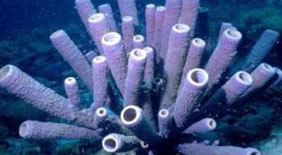
Marine sponges can help bind the reef structure.
© NOAA
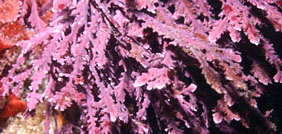
Coralline algae helps to encrust the reef framework. © NOAA
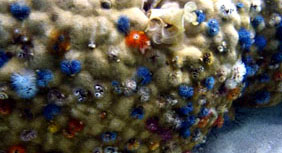
Christmas tree worms (Spyrobranchus giganteus) on Porites colony. © Endangered Species International
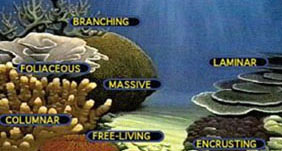
Hard coral growth types. (http://krupp.wcc.hawaii.edu)
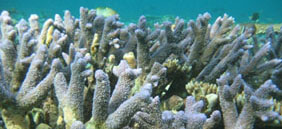
A beautiful branching Acropora vaughani providing refuge for many fish species. © Pierre Fidenci
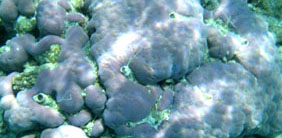
Porites sp may growth only 1 cm per year. © Pierre Fidenci
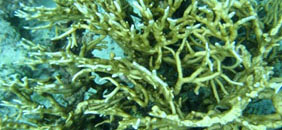
Millepora sp growth rate can be affected by changes in ocean chemistry © Pierre Fidenci
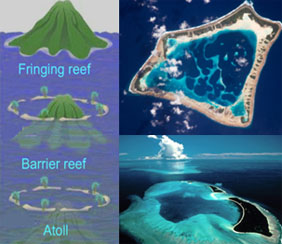
Atolls: Darwin’s theory of atoll creation.
|

